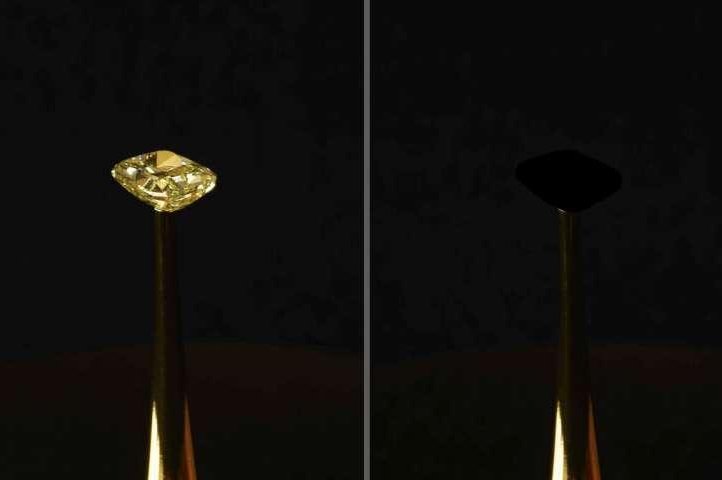Scientists used their new material to turn a $2 million diamond into a black void. Photo by R. Capanna/A. Berlato/A. Pinato
Sept. 13 (UPI) -- Material engineers at MIT have produced the blackest black material to date, 10 times blacker than previous record-black materials.
The material is composed of microscopic filaments of carbon. In the lab, scientists grew a forest of vertically aligned carbon nanotubes on a chlorine-etched aluminum foil substrate. The foil-based patch of carbon trees captures 99.96 percent of incoming light, a new record.
Researchers described the new material this week in the journal ACS Applied Materials and Interfaces.
The authors of the new paper don't expect to hold the record for very long. Eventually, the material's creators predict, material scientists will design a material that absorbs 100 percent of light.
"Our material is 10 times blacker than anything that's ever been reported, but I think the blackest black is a constantly moving target," Brian Wardle, professor of aeronautics and astronautics at MIT, said in a news release. "Someone will find a blacker material, and eventually we'll understand all the underlying mechanisms, and will be able to properly engineer the ultimate black."
To demonstrate the material's ability, scientists covered a 16.78-carat natural yellow diamond with the carpet of nanotubes, causing the diamond to disappear.
"There are optical and space science applications for very black materials, and of course, artists have been interested in black, going back well before the Renaissance," Wardle said.
Originally, Wardle and his research team set out to enhance the electrical and thermal properties of conducting materials like aluminum by growing nanotubes on them.
When aluminum is exposed to air, an oxide layer forms. The layer acts as an insulator, blocking the flow of electricity and thermal energy. During experiments, researchers realized the same ingredients he was using to grow carbon nanotubes, salt, baking soda and detergent, could be used to strip the oxide layer.
When exposed to salt, the chloride ions eat away the aluminum surface.
"This etching process is common for many metals," said MIT postdoc Kehang Cui, now a professor at Shanghai Jiao Tong University in Japan. "For instance, ships suffer from corrosion of chlorine-based ocean water. Now we're using this process to our advantage."
Wardle and Cui were able to remove the oxide layer by soaking the aluminum in a salt solution. After the layer was removed, the scientists grew nanotubes on the etched aluminum inside an oven. The etching on the aluminum surface facilitated nanotube growth at much lower temperatures.
When they finished baking the aluminum, they were surprised to find an extremely black material. The end product featured enhanced electrical and thermal properties, but it also boasted unexpected optical properties.
"I remember noticing how black it was before growing carbon nanotubes on it, and then after growth, it looked even darker," Cui said. "So I thought I should measure the optical reflectance of the sample."
The material absorbed 99.96 percent of incoming light from every angle.
Researchers suggest additional research is needed to determine exactly how the material absorbs so much light.















